Thanking Lucy at Loose and Leafy for hosting Tree Following, there’s nothing new to report about the physical state of my lovely Retama, Parkinsonia aculeata. February proved chilly, though not in any record-breaking way like so much of the United States, but cold enough that the Retama still sleeps.

Cold birds, like this White-winged Dove, continue perching on sleepy limbs.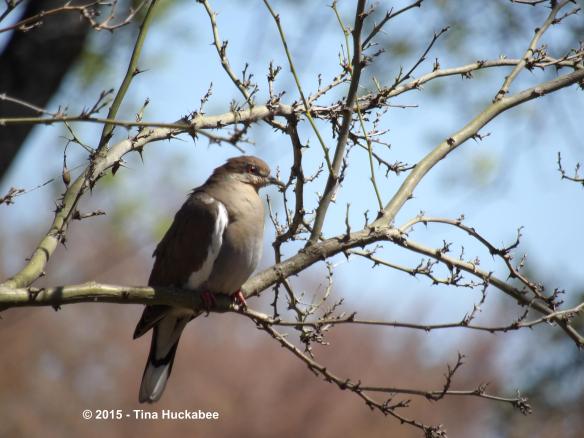
No swelling or emerging buds exist.
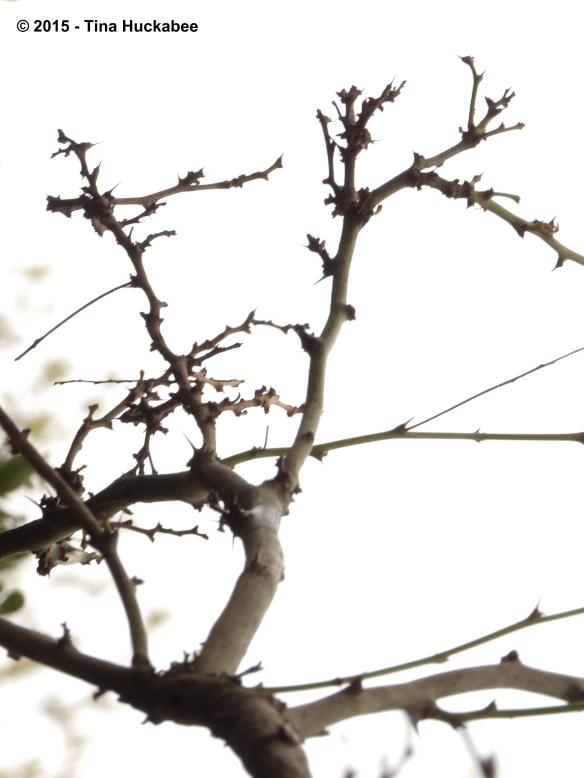
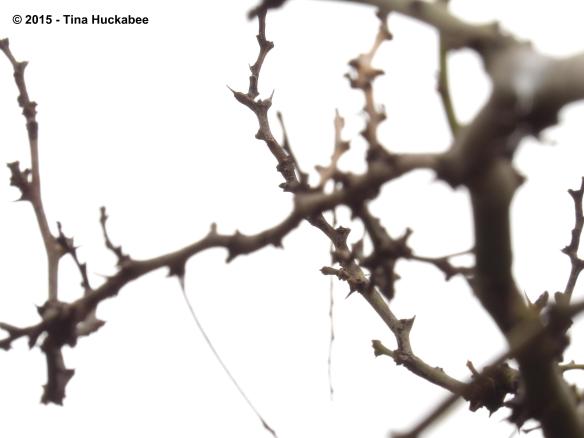
Last year’s seed pods, a few anyhow, dangle, undropped and unsprouted. 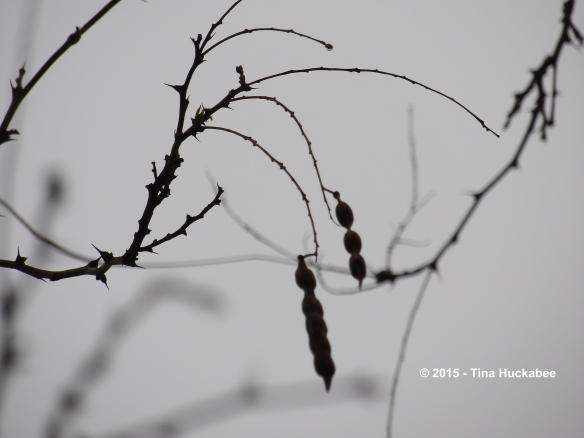
The trunk and many branches remain green, as is the way of the Retama, continuing the chlorophyll function that the tree is known for, especially during drought periods. Those nasty thorns,
 …which prick and poke this gardener from time to time, are healthy and prominent. One of the common names for P. aculeata is Jerusalem Thorn, though not because of these sharp fiends,
…which prick and poke this gardener from time to time, are healthy and prominent. One of the common names for P. aculeata is Jerusalem Thorn, though not because of these sharp fiends,
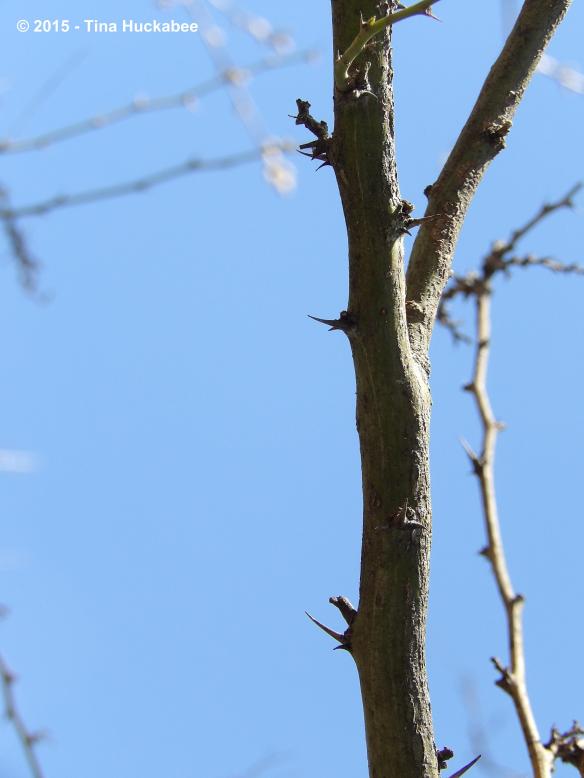 …but rather because the English name is an adulteration of the Italian/Spanish word girasol, which means sunflower, or turning toward the sun. ‘Sunflower’ or girasol is an appropriate name as the the Retama requires full sun exposure for its growing and blooming best, and the spring, summer, autumn flowers are brilliant yellow, though not of the sunflower or aster (Asteraceae) variety. The legume fruits in the earlier photo are evidence that P. aculeata is a member of the Fabaceae or Pea, family of plants.
…but rather because the English name is an adulteration of the Italian/Spanish word girasol, which means sunflower, or turning toward the sun. ‘Sunflower’ or girasol is an appropriate name as the the Retama requires full sun exposure for its growing and blooming best, and the spring, summer, autumn flowers are brilliant yellow, though not of the sunflower or aster (Asteraceae) variety. The legume fruits in the earlier photo are evidence that P. aculeata is a member of the Fabaceae or Pea, family of plants.
I’ve always called this tree Retama, but my mother referred to it using another of its common monikers, Palo Verde, which is also spelled Paloverde, from the Spanish, ‘green wood’. In reading about this great tree, I’ve discovered many other names for it. The Lady Bird Johnson Wildflower Center lists a total of six names for P. aculeata: Retama, Paloverde, Mexican Palo Verde, Jerusalem Thorn , Horsebean, Lluvia de Oro.
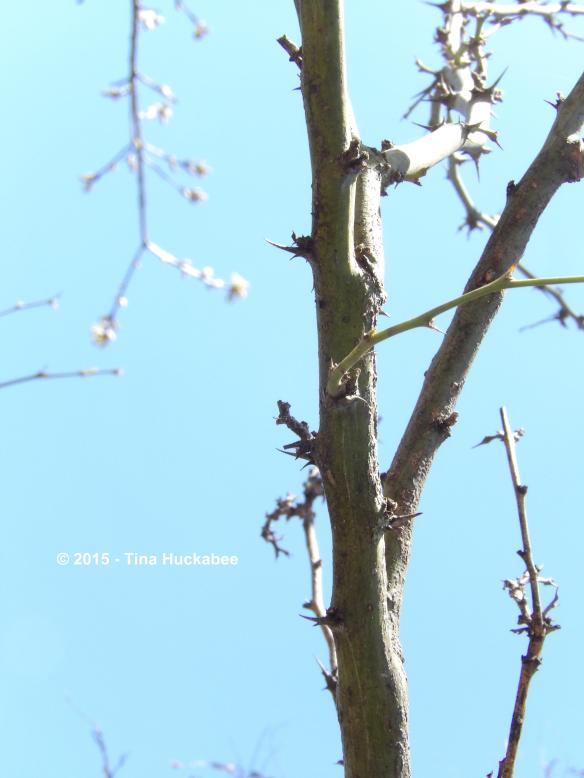
In this link from the World Agroforestry Centre, I found loads information about Retama, including a long list of names from around the world for this indigenous North American tree. Similar to most plants, not everyone calls P. aculeata by the same common name. That’s one of the interesting side stories with horticulture: as plants are globally distributed, the vernacular of plant names adopts a linguistically provincial flavor. Often, names are descriptive (‘green wood’/Paloverde) and many common plant names are quite charming and poetic. This excerpt from the section about names from the Agroforestry Centre’s article lists an array of common names in numerous languages used for P. aculeata.
Amharic (filfile,Ye eyerusalem eshoh); Arabic (sessaban,sesaban);
Bengali (balati kikar); Bislama (shewina); Creole (madame naiz,madame
yass); Dutch (boonchi strena); English (wonder tree,Mexican palo
verde,blue palo verde,takataka tree,Barbados flower fence,Jerusalem
thorn,horsebean,hardbean); French (epine de Jerusalem,arrête-
bouef,genet epineux); German (Stacheliger Ginsterßaum); Gujarati
(bawal,kikar,rombawal); Hindi (adanti,sima tumma,vilayati babul,vilayati
kikar); Indonesian (adjao kase); Italian (Ginestra spinosa); Spanish
(aroma extranjera,capinillio,capinillo,cina-cina,acacia de los
masones,bayahonda blanca,palo de rayo,sulfato,sauce
guajiro,retama,pinos japonés,pino japonés,junco
marino,paloverde,espino,mataburro,lluvia de oro,acacia de agüijote,pauji);
Swahili (mkeketa); Tigrigna (shewit hagai); Trade name (Jerusalem thorn);
Yoruba (hanson sessaban)
.
Where’s my Retama?? Funnily enough, what I call P. aculeata isn’t mentioned in the English section of the names, but it is listed in the Spanish, because retama is Spanish for ‘broom’. I used Google translator to check out the meanings of many of these words and I was surprise at how many had ‘broom’ in the translation, though not at all surprised at how many use ‘thorn(y)’ in the meanings. My favorite name for P. aculeata is the Spanish, Lluvia de oro, which translates as ‘rain of gold’. If you’ve ever seen a Retama in full, glorious bloom and some, or many, of those blooms have dropped to the ground, lluvia de oro certainly tells that story beautifully.

I fear I’m too cranky and set-in-my-ways to change what I routinely call this plant, so Retama it remains for me. Maybe I should call it by its scientific name, Parkinsonia aculeata? That’s a mouthful of words, but from where is that name gleaned? The Parkinsonia part of the equation honors the British botanist, John Parkinson, who lived from 1567-1650. While Parkinson was an important gardener and introduced new plants to England in his lifetime, he did not “discover” the genus of trees which bear his name. The naming of the New World plant genus, Parkinsonia, commemorates Parkinson’s life and horticultural contributions. The species term, aculeata, derives from the Latin, aculeatus, meaning ‘sting or prickle’. As one who’s been dinged on the head more than once by those thorns, yes, I agree that it’s aptly named.
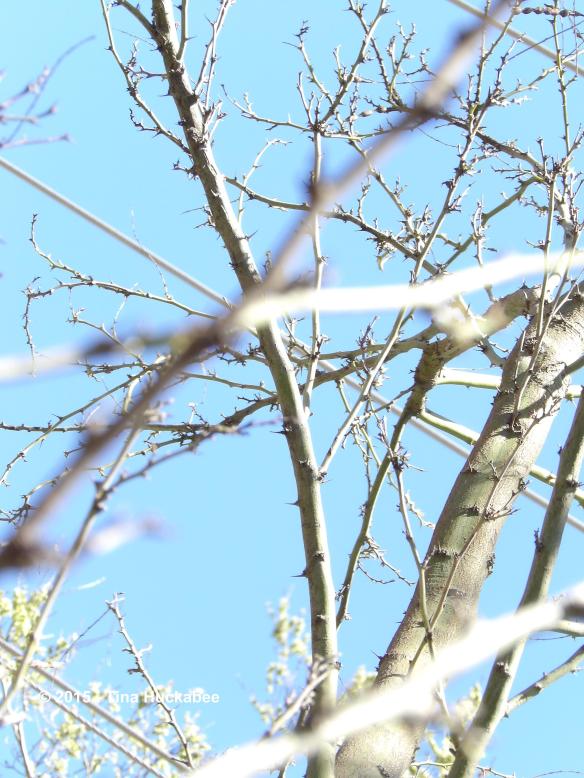
I’m not always a conscientious practitioner of proper name usage for plants, but it’s a good idea for gardeners to familiarize themselves with scientific/botanical names. The example of my followed tree, the Retama, is a good one–at a minimum, there are 50 different common names for this one little tree: Parkinsonia aculeata.
Head over to
Loose and Leafy and read about other trees from their admirers and followers.


 …which prick and poke this gardener from time to time, are healthy and prominent. One of the common names for P. aculeata is Jerusalem Thorn, though not because of these sharp fiends,
…which prick and poke this gardener from time to time, are healthy and prominent. One of the common names for P. aculeata is Jerusalem Thorn, though not because of these sharp fiends, …but rather because the English name is an adulteration of the Italian/Spanish word girasol, which means sunflower, or turning toward the sun. ‘Sunflower’ or girasol is an appropriate name as the the Retama requires full sun exposure for its growing and blooming best, and the spring, summer, autumn flowers are brilliant yellow, though not of the sunflower or aster (Asteraceae) variety. The legume fruits in the earlier photo are evidence that P. aculeata is a member of the Fabaceae or Pea, family of plants.
…but rather because the English name is an adulteration of the Italian/Spanish word girasol, which means sunflower, or turning toward the sun. ‘Sunflower’ or girasol is an appropriate name as the the Retama requires full sun exposure for its growing and blooming best, and the spring, summer, autumn flowers are brilliant yellow, though not of the sunflower or aster (Asteraceae) variety. The legume fruits in the earlier photo are evidence that P. aculeata is a member of the Fabaceae or Pea, family of plants.







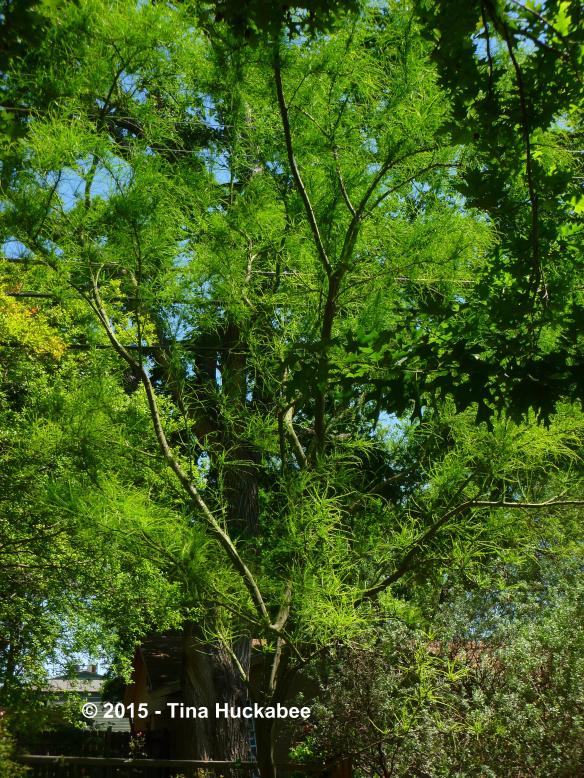
Very interesting!
I don’t think I’ve ever seen a tree like it.
LikeLike
It’s a great tree, Lea. I’ve learned so much about it, I’m glad I chose it to follow.
LikeLike
I know there are lots of Palo Verde trees in Arizona, where I grew up, but I never really appreciated them. About a year ago I was visiting there, but they weren’t quite in bloom yet. I’ll be interested to see the blooms on your tree and I’m wondering if they are popular with the bees?
LikeLike
I think one of the Parkinsonia species is the state tree of Arizona. And yes, the bees looooove the flowers.
LikeLiked by 1 person
Oh how I wish I had a full sun spot to grow one of these. Thorns or not… The green bark and yellow flowers are quite distinctive in our Central Texas tree-scape, such a wonderful contrast to oaks and juniper in both color and form. That is fascinating about the various names, I’d never heard most of them. I found myself drifting along reading, hearing the poetry in words I don’t know the meanings of… boonchi strena, mataburro… so amazing and wonderful!
LikeLike
I’m so happy with this tree and tree following has encouraged me to learn more than I probably would have under other circumstances. You know, I have lots of ‘part’ business in my gardens, part sun/part shade and indeed, this tree doesn’t really get the “full sun” that it should in ideal situations. If you have a spot that gets mostly sun, or sun in the afternoon (which in Texas definitely qualifies as full sun) you might try it.
A perfect specimen of Retama exists at Laguna Gloria where I am enrolled in an ACC ceramics class. That Retama–lets just say, it’s perfection. My tree is lovely, that tree-just, wow. It gets full sun, all day, every day.
Aren’t those names great–so poetic and beautifully descriptive. I just love some of them. One of the Spanish names is ‘mataburro’–burro killer. Great name, poor burros.
LikeLike
Such a great tree although those thorns are scary….but I love the idea of the green bark….one of my favorite trees is the Parkinsonia florida, the state tree of AZ.
LikeLike
Yep, me too. Our version is a bit smaller, I think. But I agree that it’s a wonderful genus/species of plant for the desert southwest or similar climate.
LikeLike
One of the things I like best about spring is looking at branches and guessing when the buds will break. There is such an amazing range. Some of the trees nearby already have their first flush of soft green leaves, others have fuzz pussy willows or pink swellings. And then there are the pecans who will sulk and sulk and sulk until the last possible moment. haha But I am a terrible observer because no matter how much I look the trees always surprise me. One minute a hint of buds … I turn around and the leaves seem to explode into being. I think they are all time lords.
LikeLike
I agree. It’s always fascinating to observe differing plant responses and also, how quickly something flushes out. One day there’s nothing, the next, actual leaves or blossoms.
When my son was born (20 years tomorrow. wow) I spent a great deal of time in one particular chair, as you do with a newborn. The tree that was directly in my sight was a pecan and it just took FOREVER to leaf out. I was annoyed with that pecan because I was so hungry for green.
LikeLiked by 1 person
Happy birthday to him and a happy labour day for you!
LikeLiked by 1 person
Are you getting impatient yet!? I’ve come to the conclusion that following a tree can help a person develop real patience…or just the opposite!
LikeLike
I’m ready for spring and blooms, not only from the Retama, but other pretties as well. I’ve really enjoyed this Tree Following meme–thank you Lucy, for the idea and opportunity!! It’s been so interesting to learn about the Retama. So, I guess in one way, yes, I’m a little impatient to read more and distill more information as the months pass. But, all in good time. There’s lots to observe and write about in gardening.
LikeLike
This is a new tree to me….Very informative post..Michelle
LikeLike
Lots of people in more northern parts of the US and Europe aren’t familiar, but the Parkinsonia trees are familiar in the southwest. They are great desert plants.
LikeLike
ahh … palo verde. I know that tree (from California deserts), so I guess I am familiar with retamas after all. Impressive thorns!
LikeLike
I must be the only one who calls them Retama. 🙂 Yes, Paloverde and yes, those thorns are impressive!
LikeLike
That’s an interesting post! For right now I like the Palo verde, later probably the Lluvia d’oro would seem more appropriate… “by any other name” would look as sweet 😉
LikeLike
You’re correct that there is no shortage of names, seasonally dependent or not, that this tree is bestowed with.
LikeLike
The shapes, the shapes! (Especially the one with the pods) And how wonderful it will be when we see it in full leaf. Lots to go till then I guess.
LikeLike
I’m checking daily for signs of spring budding–so far, the retama sleeps. Soon, though, there should be some action.
LikeLike
Pingback: Tree Following, April 2015: Leafy Greens | My Gardener Says…
Pingback: A Seasonal Look: Retama (Parkinsonia aculeata) | My Gardener Says…